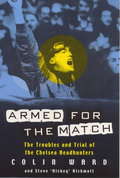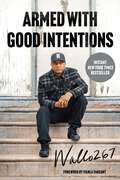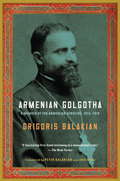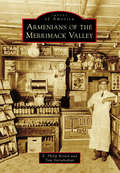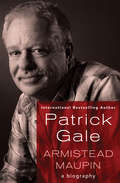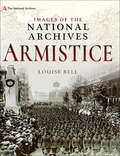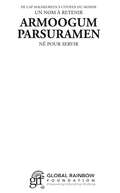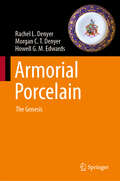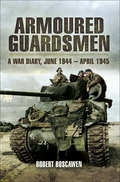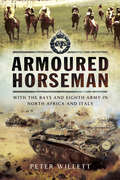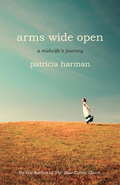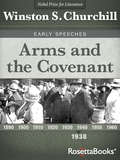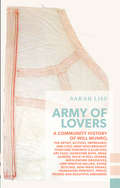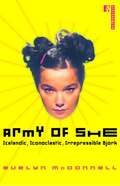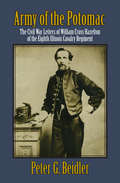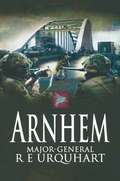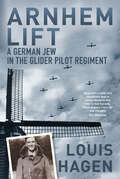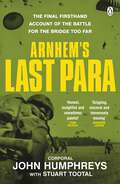- Table View
- List View
Armed for the Match
by Colin WardThroughout the 70s and early 80s English football hooligans wreaked havoc throughout England and Europe until the authorities decided that enough was enough. Chelsea supporters were targeted, and one man in particular, Steve 'Hickey' Hickmott, was deemed to be public enemy number one and arrested. This explosive story, told in Steve's own words, reveals the humour, camaraderie and escapades of life on the terraces and charts his fight for justice in the face of a system heavily biased against him, but where his battle to clear his name was eventually won.
Armed with Good Intentions
by Wallo267Wallace &“Wallo267&” Peeples spent twenty years in and out of the prison system before restarting his life and catapulting himself to unforeseen levels of social impact, cultural influence, and success. Now he shares his story with the trademark honesty that&’s made him an inspiration to those who need it most. Named after his well-respected father who disappeared when he was two, Wallo grew up in North Philadelphia with his mom, brothers, and grandmother, feeling pressure to achieve the success and reputation his father had on the streets. Spending time in and out of juvenile detention centers, school psychologists and counselors labeled him &“criminal-minded&” and his luck on the streets involving petty crimes would soon run out. After his involvement in an armed robbery, Wallo was arrested and received a prison sentence of nineteen to fifty-two years. Upon serving twenty years of his sentence, Wallo was released and returned home to Philadelphia. This memoir traces the journey from Wallo&’s youth and incarceration to his incredible success. In his time spent in prison, Wallo came to understand that he was armed with the wrong intentions despite great potential via a lack of guidance and proper mindset. With this understanding, he reckoned with the choices that put him there, accepted responsibility for his own actions, and vowed to arm himself with only good intentions upon his release. Wallo&’s reflection and new-found philosophy—which he now shares with you—informed the new trajectory of his life. On the day of his release, Wallo moved back to Philly and started on a new frontier of entrepreneurialism. Armed with vigor and intention, his viral motivational content gained Wallo over sixty-thousand Instagram followers on his first day of freedom. This would prove to only be the start of his continuously growing career utilizing his social influence as a motivational speaker, entrepreneur, and cultural changemaker. In Armed with Good Intentions, Wallo shares his hardships and triumphs and personal philosophy with his widest audience yet. Wallo spins his story of despair and tragedy into sage wisdom, inspiring anyone who is looking for the motivation to revise how they see the obstacles in their own lives.
Armenian Golgotha
by Grigoris Balakian Peter BalakianOn April 24, 1915, the priest Grigoris Balakian was arrested along with 250 other intellectuals in Constantinople, in what was to be a systematic attempt to eliminate the Armenian minority. This is a dramatic and comprehensive eyewitness account of the first modern genocide.
Armenians of the Merrimack Valley (Images of America)
by Tom Vartabedian E. Philip BrownWhen one thinks of the Merrimack Valley, shoe shops and mills come to mind. For that reason, it was a hotbed for Armenian immigrants following World War I and the genocide that robbed Armenia of half its population, with some 1.5 million victims lost at the hands of the Ottoman Turkish Empire and another million people uprooted from their homes and scattered to a Diaspora. Many of these refugees came to the Merrimack Valley--settling in the cities of Haverhill, Lawrence, and Lowell--to eke out a better life for themselves and their families. Aside from sweatshop labor, they sought work as barbers and mercenaries, business owners and handymen, going to night school for better English standards and keeping their rich heritage and culture intact with their churches and community centers. Despite the discrimination they faced with their "strange" names and lifestyles, the Armenians remained tenacious and resilient, contributing to the overall welfare of their new promised land.
Armistead Maupin (Outlines Ser.)
by Patrick GaleAn intimate biography of the gay icon whose Tales of the City changed America&’s understanding of LGBT culture during the 1970s and &’80s. Step into Armistead Maupin&’s house, and you will be greeted by a strapping young gardener, a wave of marijuana smoke, and the most gracious host in the world. When he isn&’t flitting from protests to orgies, Maupin is a natural storyteller, and San Francisco is his favorite subject. Pull up a chair and prepare to be swept away on a wave of wit, gossip, and the most outrageous sexual anecdotes you&’ve ever heard. His house seems like a scene out of his legendary Tales of the City, and that&’s no accident: Every moment of his groundbreaking series was drawn, one way or another, from Maupin&’s remarkable life, from a middle-class upbringing in North Carolina to a stint in the navy during Vietnam. Maupin landed in San Francisco just in time to chronicle the gay rights revolution that was sweeping the city and the country as a whole, and from the moment his Tales were first serialized, that city was never the same. This is an intimate biography, written by Maupin&’s longtime friend, Patrick Gale. From his fling with Rock Hudson to the darkest days of the AIDS crisis, Maupin saw it all—and lived to tell the tale.
Armistice: Armistice (Images of the National Archives)
by Louise Bell11th November 1918 saw the signing of the armistice that ended fighting between the Allies and Germany.This book will take the reader through the final year of the First World War and everything that led up to this day. Starting from the Spring Offensive, photos and images from The National Archives will highlight important points ranging from the last 100 days to the signing of the various treaties before this final armistice, finishing with a look at the Peace Parade in 1919. The physical and mental effects of the war will also be examined, and show how the war never really ended in 1918 for many.Many rarely seen images will be provided to support the narrative and further highlight the depth of The National Archives' First World War records.
Armoogum Parsuramen: De Cap Malheureux À Citoyen Du Monde
by Global Rainbow FoundationSi jamais il y avait un leader démocrate à Maurice dont l'histoire de la vie devait être écrite, le vrai et idéal ne serait autre qu'Armoogum Parsuramen. La liste de ses réalisations est trop longue pour être énumérée. C'est pourquoi sa biographie doit sortir car toute sa vie est émaillée d'activités sociales sur le plan local, national et international. Les résultats de ses réalisations ont un impact direct sur la vie des gens de partout. Cet homme est né pour servir. L'histoire s'en souviendra. Laissez son histoire se dérouler maintenant à travers cette biographie...
Armoogum Parsuramen: From Cap Malheureux To A World Citizen
by Global Rainbow FoundationIf ever there were a democratic leader in Mauritius whose life story had to be written, the true and ideal one would be none other than Armoogum Parsuramen. The list of his achievements is too long to enumerate. This is why his biography has to come out for his whole life is studded with social activities on the local, national and international plane. The results of his achievements have a direct impact on the lives of people far and wide. This man was born to serve. History will remember. Let his story unfold now through this biography...
Armorial Porcelain: The Genesis
by Howell G. Edwards Rachel L. Denyer Morgan C.T. DenyerThis book explores the genesis of armorial porcelain manufacture in Britain. While heraldic devices began appearing on Chinese porcelain from the sixteenth century onwards, armorials did not appear on British porcelain until the 1750s. It examines the development of porcelain in China and traces its introduction to Western Europe. The book delves into the market for armorial porcelains, from the early commissioning of Chinese armorial porcelainware to the establishment of manufactories in England capable of producing armorial porcelain. It also discusses the reasons behind the timing of armorial porcelain's manufacture in Britain. Additionally, it assesses armorial porcelain as a contemporary historical source. Building upon previous research by the authors, the book presents armorial porcelain as a distinct and highly personalized product. By integrating detailed genealogical research, cultural insights, and chemical analysis, it offers a comprehensive understanding of armorial porcelain within the context of heritage, culture, and science.
Armoured Guardsman: A War Diary, June 1944–April 1945
by Robert Boscowan&“A rare treat: a well-written account of what it was like to serve as a junior rank in the Brigade of Guards during the Second World War.&” —The Guards Magazine The outbreak of World War II brought many changes to Britain&’s Brigade of Guards. The dress-parade units had always maintained a full combat capacity and made a relatively easy transition into a new unit, the Guards Armoured Division. The Guards landed in Normandy on 26 June 1944 and steadily fought their way across northern Europe. Robert Boscawen was a tank commander in the 1st Coldstream Guards and had four tanks shot from under him. On the fourth occasion he was badly wounded and burned, making a difficult postwar recovery. The years after the war, however, also brought both business and political success, culminating in a twenty-three-year career in Parliament. Boscawen&’s account of Britain&’s elite at war is based on his wartime diaries. &“Tells the author&’s story in a most readable yet matter-of-fact way. It is one of the finest accounts of armoured warfare that I have ever read and I have no hesitation in recommending it to anyone who has not.&” —Tank Regiment Magazine
Armoured Horseman: With the Bays and Eight Army in North Africa and Italy
by Peter WillettA veteran with the Queen&’s Bays in the British Army recounts service during World War II and his career in horse racing post-war. New memoirs by combatants in the Second World War are sadly rare today due to the passage of time. Armoured Horsemen will be warmly welcomed as the author, now into his 90s, fought through with The Bays from Alamein to Tunis and then on up Italy until VE Day. As a young tank troop commander his chances of survival were slim and tragically many of his friends were killed. Peter Willett, a professional journalist and prolific author, is superbly qualified to describe his war and the experiences of his fellow cavalrymen. He tells a moving story with characteristic lightness of touch and modesty. As well as satisfying the military enthusiast, Armoured Horseman will find a ready audience in the racing fraternity. Peter describes equestrian activities in post-war Austria and goes on to summarise his career as a racing journalist, authority on breeding, membership of the Jockey Club and long association with Goodwood.Praise for Armoured Horseman &“Overall this is a rather entertaining description of life in a unit at the heart of some of the most significant events of the Desert War.&” —History of War &“This new book covers familiar ground, because there have been many books that tell the story of the major North African and Italian campaigns, but it brings forward a unique story that is fascinating, compelling and charming. This is a must read WWII account but it will also appeal for its horse racing connections and the very human story that it tells.&” —Firetrench &“What a truly wonderful book! I almost felt I was there and realised that between all the horrors of war there were also some better times and great friendships recounted so brilliantly. It should be made into a film!&” —Nicola Howard-Jones
Armoured Warfare in the First World War 1916-18: Rare Photographs From Wartime Archives (Images of War)
by Anthony Tucker-JonesA hundred years ago, on 15 September 1916, on the Western Front during the Battle of the Somme, the tank made its debut on the battlefield. The first tanks were crude, unreliable, vulnerable weapons, but they changed the character of land warfare forever, and Anthony Tucker-Jones's photographic history of these pioneering armored vehicles is the ideal introduction to them. In a selection of over 150 archive photographs he offers a fascinating insight into the difficult early days of this innovative new weapon, describing its technical history and its performance in combat. While the Battle of Cambrai in 1917 is often held up as the first large-scale tank battle, tanks had already served at Flers-Courcelette on the Somme, during the Nivelle offensive and the battles of Messines and Passchendaele. His book shows that the development of the tank was fraught with technical obstacles and battlefield setbacks. It was invented by the British and the French at almost the same time to help break the deadlock of trench warfare, and the British deployed it first in 1916. Belatedly the Germans followed the British and French example. The initial designs were continuously refined during two years of intense warfare. Finding the right balance between power and weight, getting the armament right, and working out the best tactics for tanks on the battlefield was a tricky, often deadly business.
Arms Wide Open
by Patricia HarmanA midwife's memoir of living free and naturally against all oddsIn her first, highly praised memoir, Patricia Harman told us the stories patients brought into her exam room, and her own story of struggling to help women as a nurse-midwife in medical practice with her husband, an OB/GYN, in Appalachia. In this new book, Patsy reaches back to tell us how she first learned to deliver babies, and digs even deeper down to tell us of her youthful experiments with living a fully sustainable and natural life.Drawing heavily on her journals, Arms Wide Open goes back to a time of counter-culture idealism that the boomer generation remembers well. Patsy opens with stories of living in the wilds of Minnesota in a log cabin she and her lover build with their own hands, the only running water being the nearby streams. They set up beehives and give chase to a bear competing for the honey. Patsy gives birth and learns to help her friends deliver as naturally as possible.Weary of the cold and isolation, Patsy moves to a commune in West Virginia, where she becomes a self-taught midwife delivering babies in cabins and homes. Her stories sparkle with drama and intensity, but she wants to help more women than healthy hippie homesteaders. After a ten-year sojourn for professional training, Patsy and her husband, Tom, return to Appalachia, as a nurse-midwife and physician, where they set up a women's-health practice. They deliver babies together, this time in hospitals; care for a wide variety of gyn patients; and live in a lakeside contemporary home--but their hearts are still firmly implanted in nature. The obstetrical climate is changing. The Harmans' family is changing. The earth is changing, but Patsy's arms remain wide open to life and all it offers.Her memoir of living free and sustainably against all odds will be especially embraced by anyone who lived through the Vietnam War and commune era, and all those involved in the back-to-nature and natural-childbirth movements.
Arms and the Covenant (Winston S. Churchill Early Speeches)
by Winston S. ChurchillThis inspiring collection of campaign speeches from the British prime minister bring his oratory brilliance and powers of persuasion to life. Legendary politician and military strategist Sir Winston Churchill was a master not only of the battlefield, but of the page and the podium. Over the course of forty books and countless speeches, broadcasts, news items and more, he addressed a country at war and at peace, thrilling with victory but uneasy with its shifting role on the global stage. In 1953, he was awarded the Nobel Prize for Literature for &“his mastery of historical and biographical description as well as for brilliant oratory in defending exalted human values.&” During his lifetime, he enthralled readers and brought crowds roaring to their feet; in the years since his death, his masterful writing has inspired generations of eager history buffs. Well before Britain entered World War II, Winston Churchill warned his government about the growing Nazi threat, even as many European leaders were still urging caution and diplomacy. In this collection of forty-one speeches from 1928 to 1938, the great politician&’s prescience and political skill—vital to Britain&’s role as the first country to stand against Hitler—are clearly on display. This collection, which includes the famous &“Disarmament Fable&” speech, presents a fascinating look at Churchill&’s campaign to mobilize Britian against the rising Nazi threat, and showcases his versatility and genius as one of the best orators of the twentieth century.
Army Life in a Black Regiment and Other Writings
by Thomas Wentworth HigginsonA stirring account of wartime experiences from the leader of the first regiment of emancipated slavesThomas Wentworth Higginson, a Unitarian minister, was a fervent member of New England's abolitionist movement, an active participant in the Underground Railroad, and part of a group that supplied material aid to John Brown before his ill-fated raid on Harpers Ferry. When the Civil War broke out, Higginson was commissioned as a colonel of the black troops training in the Sea Islands off the coast of the Carolinas. Shaped by American Romanticism and imbued with Higginson's interest in both man and nature, Army Life in a Black Regiment ranges from detailed reports on daily life to a vivid description of the author's near escape from cannon fire, to sketches that conjure up the beauty and mystery of the Sea Islands. This edition of Army Life features as well a selection of Higginson's essays, including 'Nat Turner's Insurrection' and 'Emily Dickinson's Letters. ''Has some claim to be the best written narrative to come from the Union during the Civil War. '- Henry Steele CommagerIntroduction and Notes by R. D. MADISON
Army Wife: A Story of Love and Family in the Heart of the Army
by Vicki CodyFrom the last days of the Vietnam War to the present-day war on terrorism, this story is a moving and poignant tribute to love, marriage, family, and the men and women who serve this nation. In describing her thirty-three-year journey as an Army wife, Cody gives an in-depth look at what it takes to keep a marriage strong, raise a family—oftentimes as a single parent—create a home, and face separations and loneliness amid the uncertainty and stresses that are so much a part of Army life. Over the years, Cody learns to embrace the uniqueness of her circumstances, and she finds joy, self-fulfillment, and pride in her role. But when both her sons follow in their dad’s footsteps, becoming Army Aviators and flying Apache helicopters in combat zones in Afghanistan and Iraq, Cody faces her greatest challenges as a mother and again, must balance the needs of her family with her husband’s position. Full of humor and honesty, Army Wife brings the reader into Cody’s private life in a very personal way, and in doing so opens the lens for a broader view of world events.
Army of Empire: The Untold Story of the Indian Army in World War I
by George Morton-JackDrawing on untapped new sources, the first global history of the Indian Expeditionary Forces in World War IWhile their story is almost always overlooked, the 1.5 million Indian soldiers who served the British Empire in World War I played a crucial role in the eventual Allied victory. Despite their sacrifices, Indian troops received mixed reactions from their allies and their enemies alike-some were treated as liberating heroes, some as mercenaries and conquerors themselves, and all as racial inferiors and a threat to white supremacy. Yet even as they fought as imperial troops under the British flag, their broadened horizons fired in them new hopes of racial equality and freedom on the path to Indian independence. Drawing on freshly uncovered interviews with members of the Indian Army in Iraq and elsewhere, historian George Morton-Jack paints a deeply human story of courage, colonization, and racism, and finally gives these men their rightful place in history.
Army of Lovers: A Community History of Will Munro
by Sarah LissIn the spring of 2010, Toronto lost one of its most important queer civic heroes. Weaving together interviews and stories, Army of Lovers is a biography of Will Munro and a document of a galvanizing period when various subcultures - the queer community, the art scene, the independent music universe, the grassroots activist enclaves - came together.
Army of She: Icelandic, Iconoclastic, Irrepressible Björk
by Evelyn McdonnellWearing thick glasses, speaking in her thick Icelandic accent, and, well, seeming a touch thick, Björk stormed the public consciousness in 2000 as an unlikely heroine in the experimental musical film Dancer In the Dark. Army of She is an in-depth look at the woman who first took the public stage twenty-three years ago, analyzing her rise from child prodigy to punk anarchist to New Wave novelty (as member of the Sugarcubes) to hit soloist to film star.
Army of the Potomac: The Civil War Letters of William Cross Hazelton of the Eighth Illinois Cavalry Regiment
by Peter G. BeidlerA riveting, on-the-ground account of the American Civil War by a Union cavalryman who survived most of the historic conflict’s biggest battles. William Cross Hazelton spent four years in the Civil War as a brave and devoted member of the Union cavalry. During that time he corresponded with Fannie Morrill, the young woman who would become his wife. His letters describe the life of an Illinois volunteer in the Army of the Potomac, the military unit that fought Lee’s Army of Northern Virginia in most of the big battles of the Civil War: Williamsburg, Richmond, Antietam, Fredericksburg, Chancellorsville, and Gettysburg. Hazelton describes the battles from the viewpoint of an ordinary cavalryman slogging through the mud, following erratic orders, surviving for days on enemy turf eating nothing but hardtack, and wondering why the Union army, though superior in numbers and supplies, kept losing battles. Later, when Lincoln was assassinated, Hazelton became part of the cavalry posse that chased John Wilkes Booth across the Potomac. His letters breathe new life into a war so devastating that it still scars the American psyche, while exhibiting a moral perspective far ahead of its time. Army of the Potomac is an essential, eye-opening account of one of America’s most harrowing epochs, and was a finalist in the 2013 Next Generation Indie Book Awards.
Arnhem
by R. E. UrquhartAn on-the-ground account of the 1st Airborne Division during Operation Market Garden from the British commander who led the &“Bridge Too Far&” battle. Major-General Urquhart commanded the 1st British Airborne Division in Operation Market Garden, the greatest airborne assault of World War II, the struggle to capture Arnhem and win control of the bridge across the lower Rhine. The story of the 1st Airborne Division at Arnhem involved not only an Airborne Corps of three Divisions but also the bulk of the British 2nd Army in Europe. Gen. Urquhart has told the story of those fateful nine days clearly, frankly and, despite the terrible circumstances, not without humor. It ranks as an important work, describing an operation which opened with such high hopes and left its name forever as a feat of the highest endurance and valor.
Arnhem Lift: A German Jew in the Glider Pilot Regiment
by Louis HagenOf the 10,000 men who landed at Arnhem, over nine days 1,400 were killed and more than 6,000 – about a third of them wounded – were captured. It was a bloody disaster. The remarkable Louis Hagen, an ‘enemy alien’ who had escaped to England having been imprisoned and tortured in a Nazi concentration camp as a boy just a few years earlier, was one of the minority who made it back. What makes this book so unforgettable is not only the breathtaking drama of the story itself, it is the unmistakable talent of the writer. The narrative was first published anonymously in 1945.45 years later at a dinner party in Germany, Louis Hagen met Major Winrich Behr, Adjutant to Field Marshal Model at Arnhem. Louis added his side of the story to add even more insight to the original work.
Arnhem’s Last Para: A British Paratrooper’s Memoir from Tobruk to Arnhem in World War II, for fans of The Bridge Too Far
by Stuart Tootal John HumphreysTHE FINAL LIVING TESTIMONY FROM THE ARNHEM BRIDGE - A LEGENDARY SOLDIER’S STORY, TOLD IN HIS OWN WORDSBy former paratrooper John Humphreys and bestselling author and ex-Parachute Regiment officer Stuart Tootal'A gripping, visceral and immensely moving read. Courage beyond measure, coupled with humility to act as a lesson to us all. No more fitting tribute – we remember them' Damien Lewis--A powerful and authentic account of one soldier's war from Tobruk to Arnhem and all points in between.John Humphreys was just a boy soldier in the Royal Engineers when war was declared in 1939. By the war's end he had jumped into Arnhem with the Parachute Regiment to spearhead the attack on the bridge. For days Humphreys and the rest of his squad held on, outnumbered and outgunned by the German army fighting to the last bullet and refusing to surrender.But the Bridge Too Far is only the climax of Humphreys’ remarkable war. Twice captured as a prisoner of war, he twice escaped from the enemy to make his way back to Allied lines in order to rejoin the fight.Aged 101, Humphreys began to pen his extraordinary story, with the help of bestselling author and former paratrooper Stuart Tootal. The Arnhem’s Last Para is Humphrey’s parting gift, and the final time we will read an account from a soldier of our Greatest Generation bearing witness to the heroism and sacrifice of this legendary action – told with incredible honesty and irrepressible spirit.
Arnie & Jack: Palmer, Nicklaus, and Golf's Greatest Rivalry
by Ian O'ConnorA Sports Illustrated Top Ten Book of the Year and New York Times bestseller from ESPN.com's Ian O'Connor, Arnie & Jack: Palmer, Nicklaus, and Golf's Greatest Rivalry is a revelatory look at the relationship between two legendary champions.Surprisingly, one of sport’s most contentious, complex, and defining clashes played out not in the boxing ring or at the line of scrimmage but on the genteel green fairways of the world’s finest golf courses. Arnie and Jack. Palmer and Nicklaus. Their fifty-year duel, in both the clubhouse and the boardroom, propelled each to the status of American icon and pushed modern golf into mainstream popularity.Arnie was the cowboy, with rugged good looks, Popeye-like forearms, a flailing swing, and charm enough to win fans worldwide. Jack was scientific, precise, conservative, aloof, even fat and awkward. Ultimately, Nicklaus got the better of Palmer on the course, beating him in major victories 18-7. But Palmer bested Nicklaus almost everywhere else, especially in the hearts of the public and in endorsement dollars. By the end of this page-turning narrative, we see that each man wanted what the other had: Arnold wanted the trophies. Jack wanted the love.In the tradition of John Feinstein and Mark Frost, Ian O’Connor has written a compelling account of one of the greatest rivalries in sports history.
Arnie and a House Full of Company
by Margarete S. Corbo Diane M. BarrasThe wonderful true, new story of Arnie, the famous talking starling. When Margarete returns to Cape Cod with Arnie and the three cats after a ten-year absence, she finds the family homestead so overgrown she has to prune their way to the front door. The house that had been full of love and laughter is now a lifeless shell, except for the ghost of Margarete's father in the bedroom. But, determined to make the house a home again, Margarete seeks out friends, old and new, animal and human--Edelweiss the skunk, Manx the tailless squirrel, Ekaterina the dying countess, April the neighbor who has lost her son. Soon Margarete and Arnie have filled their nest so well they begin to wonder whether there is such a thing as too much company. The first Arnie book was a story of breaking away, of letting go of dreams gone bad. The new one is a story of putting down new roots in old places. It says you can go home again.
